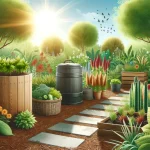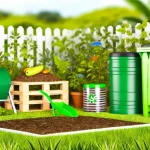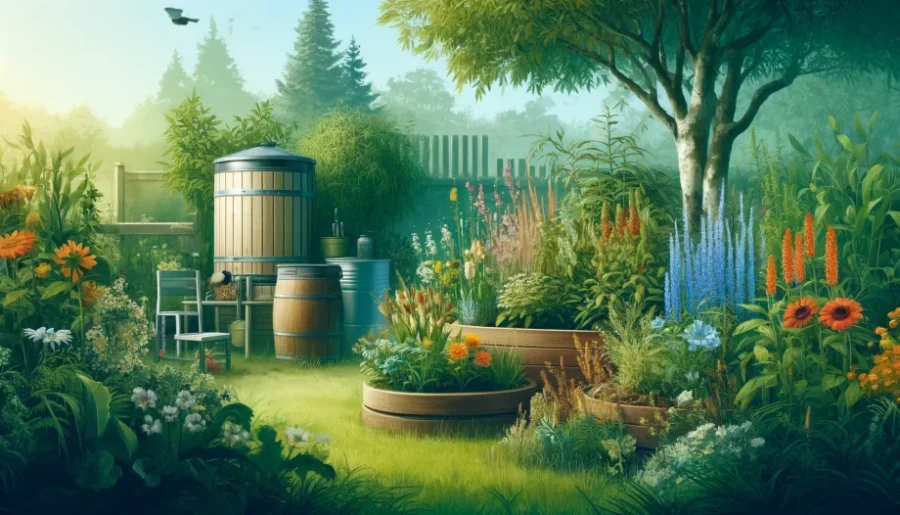
Tired of gardening techniques that suck the life out of your soil and wallet? It feels overwhelming to think about the water and chemicals many gardens demand.
Dive into the basics of sustainable gardening practices to turn your green space into an eco-friendly sanctuary that saves resources and supports local wildlife.
Sustainable Gardening Practices Key Takeaways:
- Sustainable gardening practices include using native plants, composting organic waste, and conserving water through techniques like drip irrigation and rainwater harvesting.
- These methods enhance biodiversity, improve soil health, and reduce environmental impact, supporting a more sustainable ecosystem.
Basics of Sustainable Gardening Practices
While growing plants and maintaining a garden are inherently “green” activities, sustainable gardening is about growing a greener future. So what does it mean to garden sustainably? Sustainable gardening combines organic gardening practices with resource conservation. American Horticultural Society
What is Sustainable Gardening?
Howdy folks! Sustainable gardening is more than just planting seeds; it’s about caring for our Earth. This approach goes beyond traditional digging and planting by focusing on practices that support the whole ecosystem. Let’s break it down:
Resource Conservation: Conserving What We Cherish:
- We use smart techniques like composting kitchen scraps to enrich the soil and setting up systems to catch and use rainwater. This way, every drop and scrap gets a second life in our gardens.
Promoting Biodiversity: Growing with the Local Flow:
- By choosing plants that are native to our area, we cut down on water, fend off pests naturally, and give the local birds and bugs a boost. It’s all about making choices that work with nature, not against it.
Reducing Chemical Use: Keeping It Clean:
- Steering clear of harsh chemicals keeps our gardens and homes toxin-free and helps our little corner of the planet stay healthy.
By sticking to these sustainable steps, we create gardens that do more than just look pretty—they become a thriving part of the local landscape that gives back to the environment.
It’s good for the earth, great for our souls, and just plain smart gardening.
Compost

Sustainable gardening isn’t just about growing plants; it’s about nurturing nature.
This gardening style ensures our environment thrives alongside our green patches using earth-friendly methods. Let’s dig a bit deeper:
Resource Conservation:
-
- Water Wise: Implementing systems like drip irrigation and rainwater collection.
- Soil Stewardship: Using compost to enrich soil naturally, reducing the need for chemical inputs.
Supporting Local Ecosystems:
-
- Plant Native: Choosing native plants that require less water and care, boosting local habitats.
- Encourage Wildlife: Designing gardens that attract and support pollinators and other wildlife, enhancing biodiversity.
Reducing Environmental Impact:
-
- Eco-Friendly Materials: Opting for recycled and sustainable materials in garden constructions and tools.
- Chemical-Free Approach: Avoiding synthetic pesticides and herbicides to maintain a healthy garden ecosystem.
Embracing sustainable gardening is all about making choices that help our gardens and the environment flourish together. It’s not just good gardening—it’s smart living!
Choose Native Plants
When we talk about keeping our gardens thriving with less fuss, native plants are your best bet. Here’s why sticking to the locals is a smart choice:
- Saves Water: Native plants are used to your area’s weather and soil, meaning they generally don’t need as much watering. That’s a plus during those hot, dry spells!
- No Chemicals Needed: These plants have naturally adapted to local pests and diseases, so they typically require fewer pesticides or fertilizers. Less chemicals means a happier, healthier garden.
- Supports Local Critters: Native plants provide the perfect habitat for local wildlife. They offer the right kind of food and shelter for the birds, bees, and butterflies that call your area home.
Opting for native plants not only makes gardening a bit easier but also helps maintain the natural balance of your local ecosystem. It’s good for the planet, easy on your back, and great for the critters. Keep it green, y’all!
Water Conservation
Let’s talk water. Conserving water is crucial, not just for keeping our gardens lush but also for our planet. Here are a couple of savvy strategies to cut down on water use:
- Rainwater Harvesting: Catch that rain when it falls! Setting up barrels or a rainwater collection system can capture precious rainwater. Then, use it to water your garden when it’s dry. It’s like saving for a sunny day—literally!
- Drip Irrigation: This is a real water-saver. Drip irrigation delivers water directly to the base of your plants, reducing waste and ensuring that every drop goes exactly where it’s needed. It’s efficient and can cut down on your water bill too.
Implementing these methods helps reduce reliance on municipal water systems and keeps your garden thriving in an eco-friendly way.
Plus, it’s a smart move that your plants and your wallet will thank you for. Let’s make every drop count!
Mulch
Let’s dive into the world of mulch, your garden’s best friend. Here’s why laying down some good old organic mulch, like straw or wood chips, is a game-changer for your plants:
- Moisture Control: Mulch acts like a blanket for your soil, keeping it cool and moist. This means less watering and happier plants, especially during those scorching summer days.
- Weed Suppression: Nobody likes weeding, right? Well, mulch helps keep those pesky weeds at bay by blocking light they need to grow. More time enjoying your garden, less time pulling weeds!
- Nutrient Boost: As organic mulches break down, they feed your soil with nutrients. It’s like giving your garden a slow-release natural fertilizer that keeps on giving.
Using mulch not only helps conserve water and reduce your garden chores but also enriches your soil, making your garden healthier and more vibrant. Spread a layer and watch your garden thrive!
Collect Rainwater

Let’s chat about a smart way to keep our gardens lush while being kind to our wallets and the planet by collecting rainwater:
- Use Rain Barrels: Set up a rain barrel or two to catch water from your roof via downspouts. It’s a straightforward setup that can save a lot of municipal water.
- Cost-Effective: Using rainwater reduces your water bill significantly. It’s free water, folks! Plus, it’s usually soft water, which is better for your plants than hard tap water.
- Eco-Friendly: By using rainwater, you’re reducing runoff, which can carry pollutants into our waterways. It’s a simple step that helps keep our rivers cleaner.
Collecting rainwater is a win-win—it’s good for your garden, your pocket, and the environment.
Let’s harness what Mother Nature gives us and keep our gardens thriving the green way!
Keep Seeds
Let’s talk about a real gem in sustainable gardening, saving seeds. Here’s why and how keeping seeds from one year to the next is a brilliant move:
- Preserve Plant Diversity: Saving seeds from your best-performing plants means you’re keeping those strong genetics going. This helps maintain a diverse garden that can handle different conditions and pests better.
- Cost Savings: Why buy new seeds each year when you can collect and store them from your own garden? It’s a practical way to cut costs and ensure you always have seeds on hand for next season.
- Self-Sufficiency: Seed saving moves you a step closer to a self-sufficient garden. It’s a rewarding practice that gives you a closer connection to your gardening process, watching the full cycle from seed to plant and back to seed.
Start simple with easy-to-save seeds like tomatoes, peppers, and beans, and you’ll soon have a collection that’s as sustainable as it is satisfying. Let’s keep those seeds rolling season after season!
Organic Farming
Hey there, garden lovers! Let’s talk about keeping things natural with organic farming.
Here’s why and how embracing organic methods can do wonders for your patch:
- Skip the Synthetics: Organic gardening means saying no to synthetic pesticides and fertilizers. Instead, it leans on natural alternatives like compost, manure, and biological pest controls which are gentler on the earth and our health.
- Natural Growth Techniques: It’s all about letting nature do its thing. This includes using crop rotation, green manures, and polycultures to improve soil fertility and plant health.
- Healthier Ecosystem: By avoiding harsh chemicals, you’re not only making your garden safer for you and your family but also for the wildlife that visits. This approach helps maintain a balanced ecosystem in your garden.
Organic farming isn’t just a way to grow edibles; it’s about cultivating a sustainable environment right in your backyard.
Embrace these earth-friendly practices, and your garden will thrive naturally!
Plant Trees
Let’s dig into why planting trees should be a key part of your garden strategy.
Here’s the scoop on how these mighty plants make a world of difference:
- Shade and Cooling: Trees are natural air conditioners. Planting them strategically around your home or garden can provide much-needed shade, reducing cooling costs and creating a cooler microclimate for under-canopy plants.
- Air Quality Boost: Trees are like the earth’s lungs; they breathe in carbon dioxide and exhale oxygen. Adding trees to your garden helps improve air quality, making your green space a breath of fresh air.
- Carbon Sequestration: Trees are pros at locking away carbon dioxide, a major greenhouse gas. By planting trees, you’re directly contributing to carbon sequestration efforts, which combat global warming.
Incorporating trees into your garden isn’t just about beautifying the space. It’s a powerful way to positively impact the environment and improve the quality of life around your home.
Let’s get planting and grow a greener tomorrow!
Encourage Beneficial Insects

Let’s buzz about one of nature’s finest gardening assistants, beneficial insects.
Attracting these little helpers can boost your garden’s health and yield.
Here’s why they’re important and how to bring them to your garden:
- Enhance Pollination: Bees, butterflies, and other pollinators are crucial for helping many of our plants bear fruit and seeds. Without them, our gardens would be less fruitful and colorful.
- Natural Pest Control: Ladybugs, lacewings, and parasitic wasps are just a few of the beneficial predators that can help keep harmful pests like aphids and caterpillars in check. This reduces the need for chemical pesticides.
- How to Attract Them: Planting a variety of flowers, especially those with open petals like daisies and sunflowers, provides nectar and pollen to attract these insects. Leaving a small water source out can also help, as many beneficial insects need moisture.
By inviting these beneficial bugs into your garden, you’re setting up a natural defense system and pollination crew.
It’s a simple, natural way to keep your plants healthy and thriving. Let’s make our gardens a welcoming place for these beneficial critters!
Plant Perennials
Now let’s talk about a real garden workhorse: perennial plants. These are the plants that keep on giving, year after year.
Here’s why they’re a must-have in your garden:
- Less Work: Once perennials are established, they require less effort compared to annuals. You don’t need to replant them each year, which saves time and energy.
- Resource Efficient: Because perennials don’t need to be replanted annually, they use fewer resources like water and fertilizer once they’re established. This makes them an eco-friendly choice for any garden.
- Long-Lasting Beauty: Perennials grow back stronger and bigger each year, filling your garden with color and life. From spring blossoms to autumn hues, they keep your garden vibrant across seasons.
Incorporating perennials into your garden cuts down on your gardening chores and creates a lush, dynamic landscape that evolves over the years.
So, if you’re looking for a low-maintenance and sustainable gardening option, perennials are the way to go!
Reduce Lawn Size
Let’s talk about trimming down that lawn to make your garden more sustainable and vibrant.
Reducing your lawn size can spruce up your space and benefit the environment. Here’s how and why:
- Less Water and Chemicals: Lawns can be thirsty and often require a lot of upkeep with fertilizers and pesticides. By cutting down the lawn size, you reduce the need for these inputs, making your gardening more eco-friendly.
- Plant Native Ground Covers: Replace some of that grass with native ground covers. These plants generally need less maintenance and water and provide a beautiful, lush appearance all year round.
- Create Food Gardens: Imagine replacing part of your lawn with a vegetable or herb garden. Not only does this reduce lawn maintenance, but it also provides fresh produce right from your backyard.
Decreasing the lawn area not only saves on water and chemical usage but also opens up opportunities for more diverse, interesting, and productive garden spaces.
So, consider swapping some grass for greener alternatives that keep your garden looking great and your practices green!
Save Water
Now let’s dive into some top-notch strategies to save water in our gardens.
It’s all about using smart watering techniques that minimize waste and maximize efficiency:
- Water Early in the Morning: This reduces evaporation, allowing more water to soak into the soil rather than disappearing into the air. It’s the best time to give your plants a deep drink.
- Use Soaker Hoses and Drip Irrigation: Both these methods deliver water directly to the base of your plants, right where they need it. This precision avoids wastage through evaporation and runoff, making it one of the most water-efficient ways to nurture your garden.
- Mulch Around Plants: Adding a layer of mulch retains moisture, meaning you’ll need to water less often. It also helps keep the soil cool and discourages weed growth.
Incorporating these practices keeps your garden lush and conserves a vital resource, making your gardening more sustainable and economical. Let’s make the most of every drop!
Companion Gardening
Howdy, garden lovers! Let’s talk about companion gardening, a clever way to make your garden more productive and pest-free naturally.
Here’s why planting compatible species together is a fantastic strategy:
- Natural Pest Repellent: Some plants naturally repel pests. For example, marigolds emit a smell that discourages nematodes and other pests, protecting nearby veggies like tomatoes.
- Enhanced Growth: Certain plant combinations can actually help each other grow better. Tall plants, for instance, can provide shade for sun-sensitive shorter plants, while some, like beans, can enrich the soil with nutrients that other plants can use.
- Maximize Space: By pairing plants that complement each other in height, root depth, and nutrient needs, you can make the most of every inch of garden space. This is especially handy in smaller gardens where space is at a premium.
Companion gardening is a natural, efficient way to boost your garden’s health and yield.
It’s about creating a community of plants where each member helps the others thrive.
Dive into companion planting and watch your garden transform into a more productive and harmonious ecosystem!
Garden Design
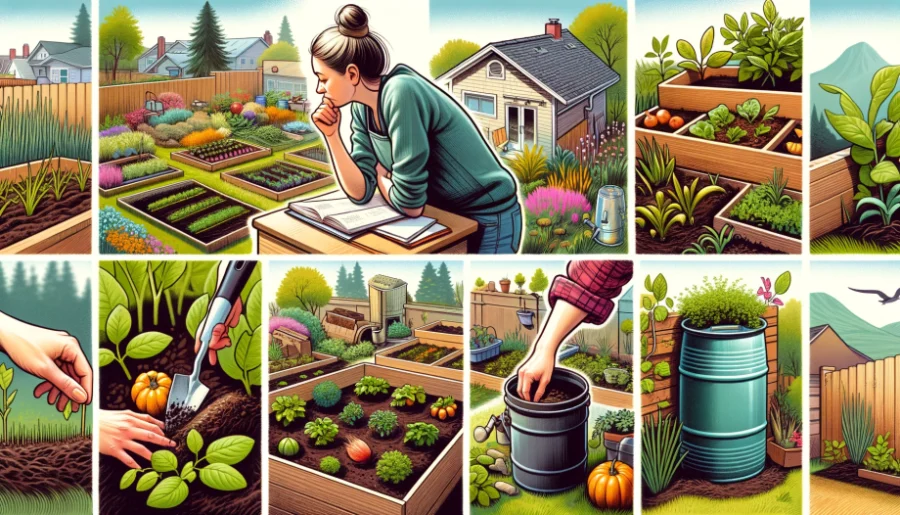
Let’s get into designing a garden that’s not just beautiful but also brilliantly self-sustaining.
Here’s how you can lay out your garden to harness the power of nature:
- Utilize Natural Light: Plan your garden layout by observing how sunlight moves across your space throughout the day. Position sun-loving plants where they’ll get plenty of light, and tuck shade-tolerant plants where the sun’s rays are softer.
- Manage Water Flow: Consider the natural slope of your land and use it to direct rainwater to plants that need more moisture. Installing a rain garden in low-lying areas can also help manage excess water and reduce irrigation needs.
- Companion Planting: Strategically place plants that benefit each other close together. This could mean pairing plants that repel pests naturally with those that are vulnerable, or growing deep-rooted plants alongside shallow-rooted ones to optimize nutrient uptake.
By thinking about how each element of your garden interacts with the others, you can create a layout that works with nature, reducing the need for manual labor and inputs.
It’s about setting up a system where plants help each other thrive. Ready to plan your self-sustaining garden?
Let’s make it happen, and remember to keep it green!
Integrated Pest Management
Howdy, gardeners! Let’s dig into Integrative Pest Management (IPM), a smart strategy to tackle those pesky garden critters while being kind to our planet.
Here’s the lowdown on using IPM to keep pests in check:
- Understand and Monitor: IPM starts with getting to know the pests in your garden. Regular monitoring and identifying what bugs are actually harmful helps you decide if and when action is needed.
- Preventive Cultural Practices: Healthy plants are less likely to succumb to pests. Rotate crops, select disease-resistant varieties, and maintain healthy soil. This makes your garden less inviting to pests.
- Mechanical Controls: Before reaching for any chemicals, try physical methods. This can be as simple as hand-picking pests off plants, using barriers or traps, or disrupting the breeding cycle.
- Biological Controls: Utilize natural predators like ladybugs or parasitic wasps to control pest populations. These beneficial insects are nature’s way of keeping the balance.
- Responsible Pesticide Use: If all else fails and pesticides are necessary, choose the least toxic option and apply it in a way that minimizes harm to other wildlife or people.
IPM is all about making smart choices to manage pests with the least possible harm to the environment.
It’s a thoughtful approach that benefits both your garden and the earth.
Let’s manage those pests wisely and keep our gardens thriving!
Reduce Pesticide Use
Let’s chat about reducing our use of chemical pesticides, focusing instead on more natural methods to keep our gardens healthy and thriving.
Here’s how you can cut down on chemicals and still keep those pests at bay:
- Embrace Natural Predators: Encourage beneficial insects, like ladybugs, praying mantises, and beneficial nematodes, that prey on harmful pests. These natural allies can help keep pest populations under control without the need for chemicals.
- Plant Diversity: Plant a variety of species that naturally deter pests. For instance, marigolds emit a scent that repels nematodes and other insects, while garlic can help fend off aphids.
- Physical Barriers: Use row covers, netting, or collars around young plants to physically block pests from reaching them. This can be especially effective against larger pests like birds and some insects.
- Cultural Practices: Rotate crops and keep your garden clean of debris where pests might breed. Healthy, well-cared-for plants are less likely to succumb to pest invasions.
- DIY Remedies: Consider natural remedies like neem oil, diatomaceous earth, or homemade insecticidal soaps that have minimal impact on non-target species and degrade quickly in the environment.
By reducing our reliance on chemical pesticides, we not only make our gardens safer for wildlife and ourselves but also contribute to a healthier ecosystem overall.
Let’s nurture our gardens the natural way, folks!
Reduce Waste
Reducing waste in our gardens isn’t just about keeping things tidy. It’s about sustainability and making the most of what we have.
Here’s how you can minimize waste and keep your garden green in more ways than one:
- Composting Plant Waste: Turn your garden trimmings and old plants into compost instead of tossing them out. This not only reduces waste but also improves your soil’s health and fertility.
Read more about composting methods at home.
- Use Environmentally Friendly Materials: Opt for biodegradable pots and natural materials like bamboo and wood for garden structures. These materials break down naturally and won’t add to landfill waste.
- Repurpose and Recycle: Get creative with old containers and garden tools. An old wheelbarrow can become a striking plant display, and empty yogurt containers can serve as seed starters. It’s about seeing the potential in things before throwing them away.
- Water Conservation: Implement systems to reuse water, like using greywater from your home or collecting rainwater. This helps reduce the demand on your local water supply and minimizes runoff.
By focusing on these strategies, you reduce your environmental footprint, and create a more sustainable, efficient, and cost-effective garden. Let’s keep our gardens lush and our planet a little cleaner!
Use Recycled Materials
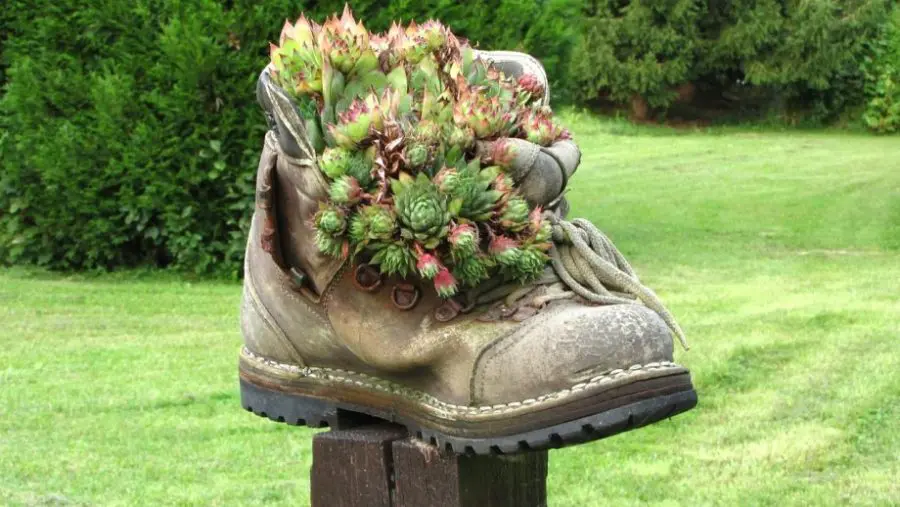
Let’s dig into using recycled materials in our gardens. This smart move not only saves money but also helps reduce our environmental footprint.
Here’s how you can incorporate recycled materials in your green space:
- Garden Tools: Instead of buying new, look for second-hand tools from garage sales or thrift stores. You can often find quality items that just need a bit of cleaning or a new handle to be as good as new.
- Plant Containers: Get creative with containers by repurposing items like old tires, broken buckets, and large food cans. Just make sure to add some drainage holes before you plant.
- Garden Decor: Items like old ceramic dishes, broken tiles, and worn-out boots can be turned into decorative accents or even planters. This adds a unique, personal touch to your garden.
- Structures: Use reclaimed wood or metal to build trellises, fencing, or garden beds. These materials often add character and rustic charm to your garden space.
Using recycled materials reduces waste and adds a story and aesthetic value to your garden.
It’s a win-win for both the environment and your wallet! Let’s keep those materials cycling and our gardens growing.
Avoid Herbicides
Let’s talk about keeping our gardens clean and green by avoiding chemical herbicides.
Here’s how we can manage weeds without harming our soil or water:
- Manual Weeding: Sometimes, the old-fashioned way is best. Pulling weeds by hand or with tools ensures complete removal without chemicals. It’s a bit of work but gives you total control over what’s growing in your garden.
- Organic Mulching: Lay down a layer of organic mulch like straw, bark, or grass clippings. This not only suppresses new weeds by blocking sunlight but also adds nutrients to the soil as it decomposes.
- Natural Herbicides: If manual weeding isn’t an option, consider natural herbicide options like vinegar or corn gluten meal. These can help control weeds without the downsides of chemical herbicides.
- Boiling Water: Pouring boiling water directly on weeds can effectively kill them and their seeds. It’s a simple, immediate solution for troublesome areas.
By shunning chemical herbicides and using these alternatives, you’re not just taking care of your garden, but also protecting the environment. Let’s keep our gardens safe and healthy naturally!
Climate Appropriate Plants
Howdy, garden enthusiasts! Let’s talk about the benefits of choosing plants that are right at home in your local climate.
This smart gardening strategy minimizes upkeep and maximizes success.
Here’s how you can select the best plants for your area:
- Research Local Flora: Start by understanding what naturally thrives in your region. Check out local gardening books, consult with area gardeners, or visit a nearby botanical garden for ideas.
- Reduce Resource Use: Plants adapted to your climate will naturally require less artificial heating, cooling, and even watering. This means less effort for you and more stability for the plants.
- Native Plant Benefits: Native plants are typically more resistant to local pests and diseases and will integrate better with the local ecosystem, supporting native birds, insects, and wildlife.
- Consult Zone Maps: Use gardening zone maps to determine which plants are best suited for the temperature and weather conditions in your area. This can prevent planting mishaps and increase your garden’s overall health.
Choosing climate-appropriate plants isn’t just about easier gardening. It’s about creating a more sustainable and resilient garden environment.
Let’s plant smart and keep our gardens flourishing naturally!
Eliminate Chemical Use
Let’s get serious about one of the most impactful steps we can take in our gardens: eliminating the use of synthetic chemicals.
Here’s why and how you can make this beneficial change:
- Soil Health: Synthetic chemicals can disrupt the natural microbial activity in the soil, which is essential for nutrient cycling and plant health. By cutting out these chemicals, you allow your soil to regenerate and maintain its fertility naturally.
- Protect Waterways: Chemicals can leach into groundwater and runoff into local water bodies, harming aquatic life and contaminating water sources. Going chemical-free helps protect these vital resources.
- Support Local Biodiversity: Chemicals often kill more than just the targeted pests; they can also harm beneficial insects, birds, and even small mammals. Using natural pest control methods helps preserve the broader ecosystem.
- Safer Environment: Removing synthetic chemicals from your gardening practice makes your yard a safer place for your family, pets, and any wildlife that visits your garden.
How to Go Chemical-Free:
- Companion Planting: This can naturally repel pests and reduce the need for interventions.
- Natural Remedies: Solutions like neem oil, soapy water, or homemade sprays from garlic and pepper can manage pests without harsh chemicals.
- Physical Barriers: Use row covers, nets, or collars around plants to physically protect them from pests and diseases.
By committing to a chemical-free garden, you’re not just cultivating plants; you’re growing a healthier ecosystem.
Let’s keep our gardens lush and our environments pure!
Grow Your Own
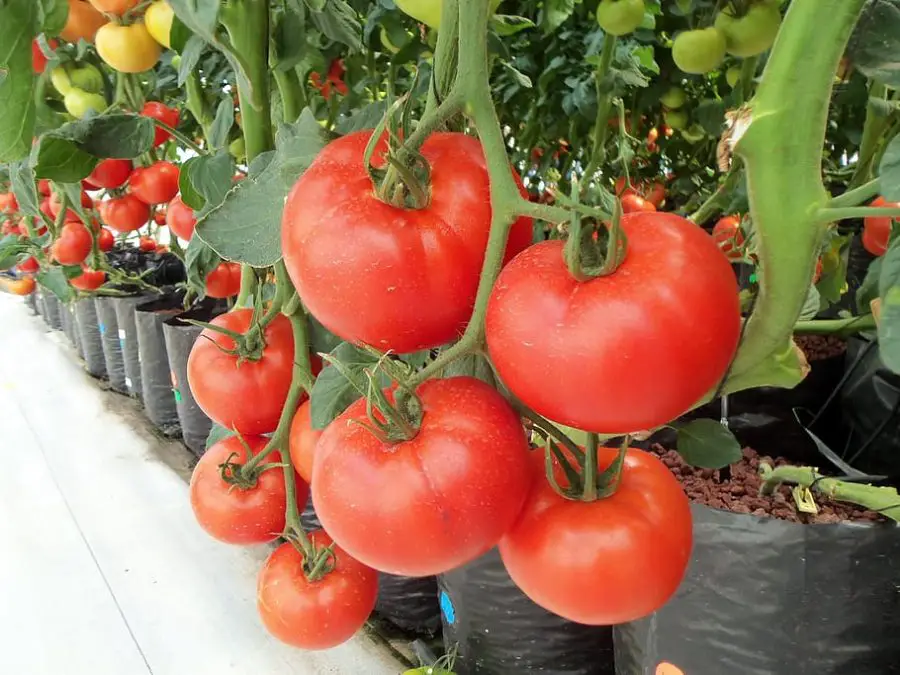
Let’s talk about the joys and benefits of growing your own fruits, vegetables, and herbs right in your own backyard, balcony, or windowsill.
Here’s why cultivating your own produce is a green and tasty choice:
- Reduce Your Carbon Footprint: Transporting food from farms to your plate can rack up a lot of carbon emissions. By growing your own, you drastically cut down on the miles your food travels, reducing your overall carbon footprint.
- Fresh and Healthy: Nothing beats the flavor and nutritional value of freshly picked produce. When you grow your own, you know exactly what goes into (and what doesn’t go into) your plants, ensuring you have the healthiest food possible.
- Food Security: Having a garden can provide a steady supply of food, which can be particularly comforting in uncertain times. It’s a step towards self-sufficiency that can make a big difference in your household.
- Therapeutic Benefits: Gardening is not just good for your body—it’s good for your soul. Tending to plants can be a relaxing and meditative activity that reduces stress and improves mental health.
- Educational for All Ages: Whether it’s kids or adults, everyone can learn from growing their own food. It’s a hands-on way to educate about nature, agriculture, and nutrition.
Starting your own garden might seem daunting, but even small container gardens can yield a surprising amount of produce.
Let’s get planting and enjoy the fruits (and veggies) of our labor!
Soil Health
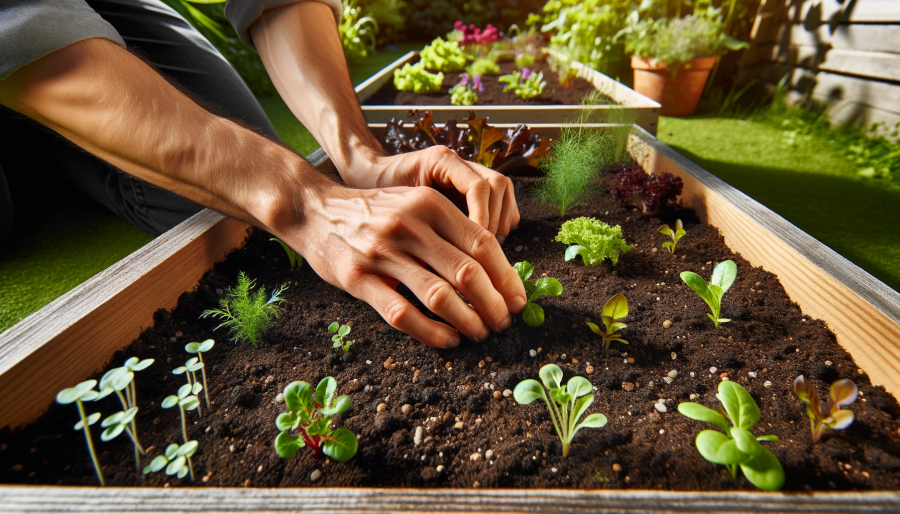
Let’s dig into the heart of gardening namely soil health. Healthy soil is the foundation of any thriving garden, and maintaining it doesn’t have to involve harsh chemicals.
Here’s how you can keep your soil rich and productive:
- Regular Testing: Knowing what’s in your soil is the first step to understanding what it needs. Soil tests can tell you about pH levels, nutrient content, and more. This knowledge helps you tailor your soil amendments precisely to your garden’s needs.
- Natural Amendments: Based on your soil test results, add organic matter like compost, aged manure, or leaf mold to improve soil structure and nutrient content. These natural amendments not only enrich the soil but also improve its ability to retain water and nutrients.
- Crop Rotation and Cover Crops: Rotate your crops and plant cover crops to help maintain soil fertility and structure. This prevents soil depletion and keeps your garden healthy year after year.
- Minimize Tilling: Tilling can disrupt soil structure and harm beneficial microorganisms. Try to minimize how often and how deeply you till your garden beds.
- Encourage Biological Diversity: The presence of worms, beneficial insects, and microorganisms is a sign of healthy soil. Maintain a diverse garden that encourages these beneficial creatures by using mulches and avoiding pesticide use.
By focusing on these natural and sustainable practices, you ensure your garden’s soil is not just alive but thriving.
Healthy soil leads to healthy plants, which means a more bountiful and beautiful garden for you.
Let’s keep that soil healthy and watch our gardens flourish!
Educational and Community Involvement
Now let’s talk about how getting involved in community gardening projects or educational programs can do wonders for your green thumb and your community.
Here’s why and how you can make a big impact:
- Spread Sustainable Practices: Joining or leading workshops and programs helps spread the word about sustainable gardening techniques. It’s a great way to share knowledge about eco-friendly practices that can benefit everyone in the community.
- Enhance Local Green Spaces: By getting involved in community gardens, you help beautify and improve local green spaces, which can become vital parts of urban environments. These spaces not only provide fresh produce but also serve as peaceful retreats for people to connect with nature.
- Build Community Bonds: Working together in a garden builds a sense of community and belonging. It’s a chance to meet neighbors, make friends, and work together towards a common goal.
- Educational Opportunities for All Ages: Community gardens are fantastic educational resources for children and adults alike. They offer hands-on learning experiences about where food comes from, the importance of biodiversity, and how to care for the environment.
- Advocacy and Policy Influence: Active participation in gardening and environmental education can also lead to advocacy for greener policies in local government. Engaged citizens can influence positive changes that support sustainability at a broader level.
Getting involved doesn’t require a huge commitment—start small, maybe by attending a local workshop or volunteering at a nearby community garden.
Every little bit helps foster a sustainable, knowledgeable, and connected community. Let’s dig in and make a difference together!
FAQs: Sustainable Gardening Practices
Got questions on how to make your garden greener? You’re not alone!
Here are some frequently asked questions about sustainable gardening, with straightforward answers to help you cultivate a more eco-friendly and productive garden.

